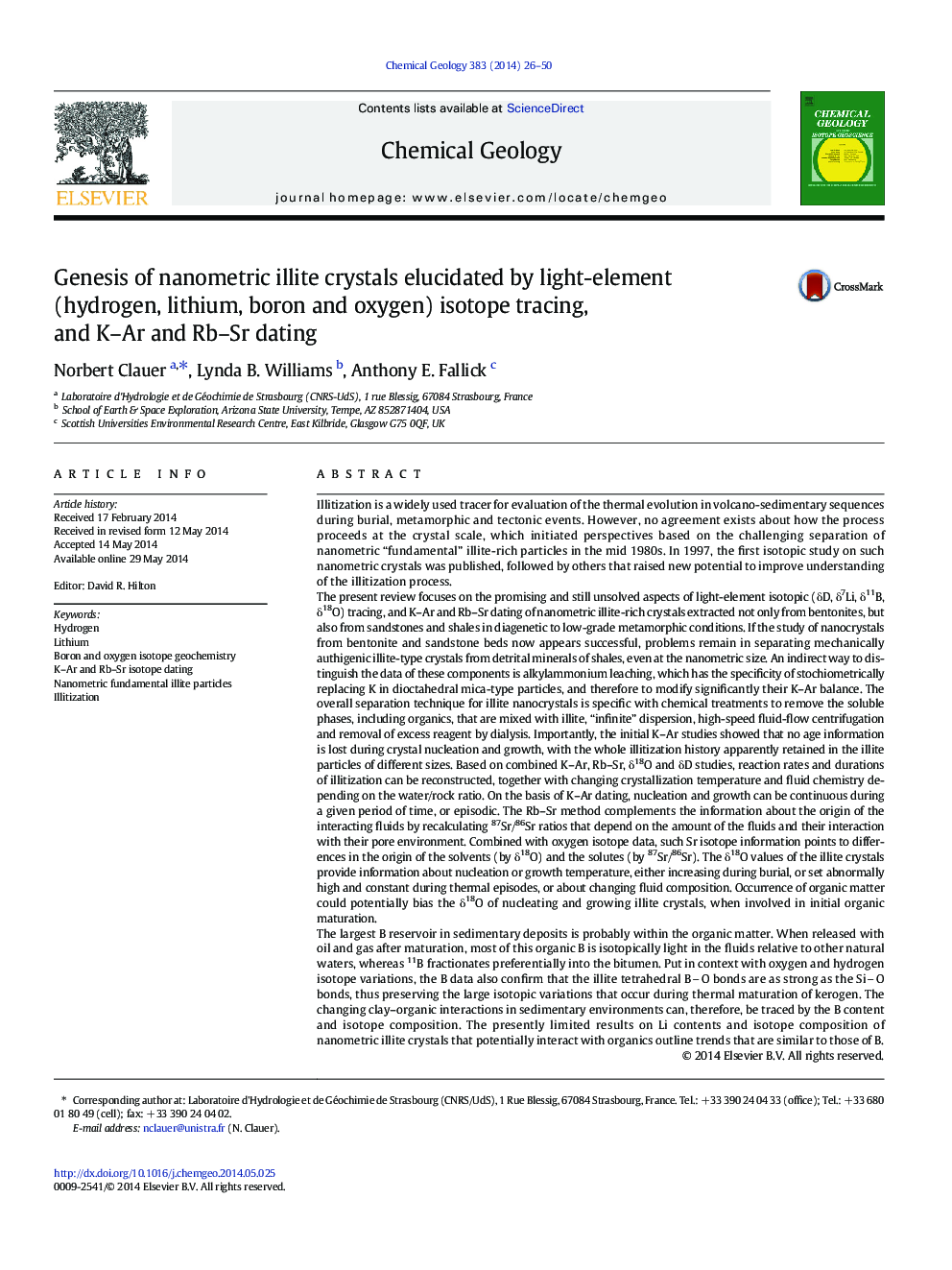| کد مقاله | کد نشریه | سال انتشار | مقاله انگلیسی | نسخه تمام متن |
|---|---|---|---|---|
| 4698673 | 1637589 | 2014 | 25 صفحه PDF | دانلود رایگان |

• This note evaluates light-element (H, Li, B, O) isotope tracing and K-Ar and Rb-Sr dating of nanometric illite crystals
• Reaction rates and durations of illitization can be recalculated with changing crystallization temperature and fluid chemistry
• Combined δ18O and 87Sr/86Sr data point to differences in the origin of the fluids (by δ18O) and their solutes (by 87Sr/86Sr)
• The largest B reservoir in sediments is within the organic matter. After maturation, 10B goes in fluids and 11B in the bitumen
• Changing clay-organic interactions in sedimentary environments can be traced by their B contents and isotope compositions δ18O
Illitization is a widely used tracer for evaluation of the thermal evolution in volcano-sedimentary sequences during burial, metamorphic and tectonic events. However, no agreement exists about how the process proceeds at the crystal scale, which initiated perspectives based on the challenging separation of nanometric “fundamental” illite-rich particles in the mid 1980s. In 1997, the first isotopic study on such nanometric crystals was published, followed by others that raised new potential to improve understanding of the illitization process.The present review focuses on the promising and still unsolved aspects of light-element isotopic (δD, δ7Li, δ11B, δ18O) tracing, and K–Ar and Rb–Sr dating of nanometric illite-rich crystals extracted not only from bentonites, but also from sandstones and shales in diagenetic to low-grade metamorphic conditions. If the study of nanocrystals from bentonite and sandstone beds now appears successful, problems remain in separating mechanically authigenic illite-type crystals from detrital minerals of shales, even at the nanometric size. An indirect way to distinguish the data of these components is alkylammonium leaching, which has the specificity of stochiometrically replacing K in dioctahedral mica-type particles, and therefore to modify significantly their K–Ar balance. The overall separation technique for illite nanocrystals is specific with chemical treatments to remove the soluble phases, including organics, that are mixed with illite, “infinite” dispersion, high-speed fluid-flow centrifugation and removal of excess reagent by dialysis. Importantly, the initial K–Ar studies showed that no age information is lost during crystal nucleation and growth, with the whole illitization history apparently retained in the illite particles of different sizes. Based on combined K–Ar, Rb–Sr, δ18O and δD studies, reaction rates and durations of illitization can be reconstructed, together with changing crystallization temperature and fluid chemistry depending on the water/rock ratio. On the basis of K–Ar dating, nucleation and growth can be continuous during a given period of time, or episodic. The Rb–Sr method complements the information about the origin of the interacting fluids by recalculating 87Sr/86Sr ratios that depend on the amount of the fluids and their interaction with their pore environment. Combined with oxygen isotope data, such Sr isotope information points to differences in the origin of the solvents (by δ18O) and the solutes (by 87Sr/86Sr). The δ18O values of the illite crystals provide information about nucleation or growth temperature, either increasing during burial, or set abnormally high and constant during thermal episodes, or about changing fluid composition. Occurrence of organic matter could potentially bias the δ18O of nucleating and growing illite crystals, when involved in initial organic maturation.The largest B reservoir in sedimentary deposits is probably within the organic matter. When released with oil and gas after maturation, most of this organic B is isotopically light in the fluids relative to other natural waters, whereas 11B fractionates preferentially into the bitumen. Put in context with oxygen and hydrogen isotope variations, the B data also confirm that the illite tetrahedral BO bonds are as strong as the SiO bonds, thus preserving the large isotopic variations that occur during thermal maturation of kerogen. The changing clay–organic interactions in sedimentary environments can, therefore, be traced by the B content and isotope composition. The presently limited results on Li contents and isotope composition of nanometric illite crystals that potentially interact with organics outline trends that are similar to those of B.
Journal: Chemical Geology - Volume 383, 15 September 2014, Pages 26–50